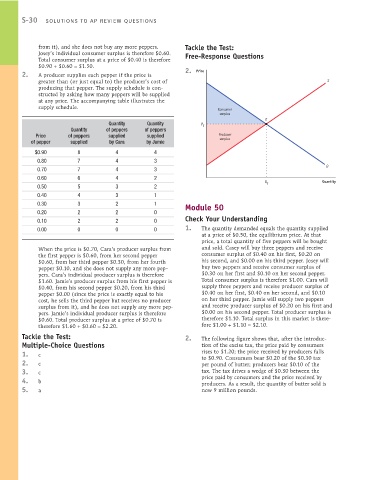Page 876 - Krugmans Economics for AP Text Book_Neat
P. 876
S-30 SOLUTIONS TO AP REVIEW QUESTIONS
from it), and she does not buy any more peppers. Tackle the Test:
Josey’s individual consumer surplus is therefore $0.60. Free-Response Questions
Total consumer surplus at a price of $0.40 is therefore
$0.90 + $0.60 = $1.50.
2. A producer supplies each pepper if the price is 2. Price
greater than (or just equal to) the producer’s cost of S
producing that pepper. The supply schedule is con-
structed by asking how many peppers will be supplied
at any price. The accompanying table illustrates the
supply schedule. Consumer
surplus
E
Quantity Quantity P E
Quantity of peppers of peppers
Price of peppers supplied supplied Producer
surplus
of pepper supplied by Cara by Jamie
$0.90 8 4 4
0.80 7 4 3
D
0.70 7 4 3
0.60 6 4 2
Q E Quantity
0.50 5 3 2
0.40 4 3 1
0.30 3 2 1
Module 50
0.20 2 2 0
Check Your Understanding
0.10 2 2 0
1.
0.00 0 0 0 The quantity demanded equals the quantity supplied
at a price of $0.50, the equilibrium price. At that
price, a total quantity of five peppers will be bought
When the price is $0.70, Cara’s producer surplus from and sold. Casey will buy three peppers and receive
the first pepper is $0.60, from her second pepper consumer surplus of $0.40 on his first, $0.20 on
$0.60, from her third pepper $0.30, from her fourth his second, and $0.00 on his third pepper. Josey will
pepper $0.10, and she does not supply any more pep- buy two peppers and receive consumer surplus of
pers. Cara’s individual producer surplus is therefore $0.30 on her first and $0.10 on her second pepper.
$1.60. Jamie’s producer surplus from his first pepper is Total consumer surplus is therefore $1.00. Cara will
$0.40, from his second pepper $0.20, from his third supply three peppers and receive producer surplus of
pepper $0.00 (since the price is exactly equal to his $0.40 on her first, $0.40 on her second, and $0.10
cost, he sells the third pepper but receives no producer on her third pepper. Jamie will supply two peppers
surplus from it), and he does not supply any more pep- and receive producer surplus of $0.20 on his first and
pers. Jamie’s individual producer surplus is therefore $0.00 on his second pepper. Total producer surplus is
$0.60. Total producer surplus at a price of $0.70 is therefore $1.10. Total surplus in this market is there-
therefore $1.60 + $0.60 = $2.20. fore $1.00 + $1.10 = $2.10.
Tackle the Test: 2. The following figure shows that, after the introduc-
Multiple-Choice Questions tion of the excise tax, the price paid by consumers
1. c rises to $1.20; the price received by producers falls
2. c to $0.90. Consumers bear $0.20 of the $0.30 tax
per pound of butter; producers bear $0.10 of the
3. c tax. The tax drives a wedge of $0.30 between the
4. b price paid by consumers and the price received by
producers. As a result, the quantity of butter sold is
5. a now 9 million pounds.

